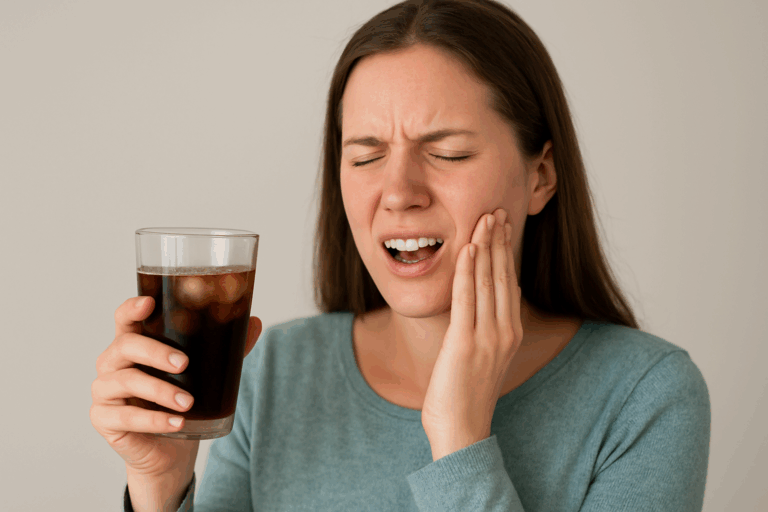
Tooth pain when drinking something cold is usually caused by exposed dentin or roots, leaving the sensitive inner layers of your teeth vulnerable to temperature changes. Common culprits include enamel erosion, gum recession, cavities, cracks, and teeth grinding, all of which can make everyday activities like eating, drinking, or even breathing in cold air uncomfortable. Because tooth pain can signal deeper issues, it’s important to see your dentist for an accurate diagnosis, effective treatment, and preventive care to protect your smile and avoid more serious problems down the road.
At Dental Depot of Arizona, we know how disruptive tooth pain can be, and we’re here to help. Our team provides comprehensive and affordable dental care, from routine checkups to advanced treatments, all delivered with the expertise needed to relieve discomfort and protect your smile. With multiple convenient locations across the state and same-day emergency dental services, we make it easy to get the care you need, when you need it.
Tooth pain when you drink something cold usually comes down to sensitivity in the parts of your tooth that aren’t as well protected as enamel. One common cause is the exposure of the inner layers of your tooth, which are closely connected to nerves. Another is the exposure of the tooth’s root, which is covered by gums rather than enamel and contains nerve tissue of its own. When either of these areas is exposed, the nerves can react strongly to temperature changes—like the chill from an icy drink—leading to that sharp, uncomfortable sensation.
There are several reasons this nerve or root exposure can happen, from everyday wear to underlying dental issues. Here are five of the most common causes.
Enamel is the hard, outer layer of your teeth. It is the strongest substance in your body, even harder than bone, but despite its strength, enamel can still wear down over time. As it erodes, the middle layer of your tooth, called dentin, becomes exposed, which can trigger pain and sensitivity when drinking something cold. If left untreated, enamel erosion can lead to more frequent and severe discomfort.
Because enamel cannot grow back once it’s gone, early care is key. You can’t replace lost enamel, but you can strengthen what remains and prevent further erosion.
Gum recession happens when the gums pull away from your teeth, often as a protective response to irritation or damage. When gums recede too far, they expose the roots of your teeth, which are more sensitive and less protected than enamel. This is a common reason cold drinks cause sudden pain.
Like enamel erosion, gum recession cannot be reversed. However, your dentist can help you stop it from progressing. In advanced cases, procedures like gum grafts may be needed to restore lost tissue.
Cavities are one of the most common dental issues, affecting nearly 90% of adults at some point. They’re essentially small holes in your teeth caused by bacteria. Similar to enamel erosion, cavities expose the more sensitive inner layers of your teeth, leading to pain when eating or drinking cold foods and beverages.
Dry mouth is another risk factor, since saliva helps wash away bacteria. Without enough saliva, bacteria stick around longer and increase the chance of decay.
Accidents happen, whether it’s a fall, a blow to the mouth, or even biting into something hard like a popcorn kernel. Cracks and chips can expose the sensitive inner layers of your teeth, making cold drinks especially painful. Even small fractures can worsen over time, so if you suspect a crack or chip, see your dentist right away for treatment before the problem grows.
Bruxism is the habit of grinding or clenching your teeth, either while awake or during sleep. It can be triggered by stress, anxiety, certain medications, or lifestyle factors like smoking. Over time, the constant pressure and friction wear down enamel, leaving your teeth more vulnerable to sensitivity and even cracks. As the dentin and pulp layers become exposed, cold foods and drinks can cause sharp discomfort.
If you’re experiencing tooth pain when you drink something cold, you may notice it in other situations, too. That’s because the same exposed dentin or roots that react to cold can also respond to heat, sugar, acid, pressure, or even airflow. In these scenarios, the nerves inside your teeth are being triggered in much the same way, producing that sharp, uncomfortable sensation.
Infection and disease can also cause tooth pain.
Normally, drinking something cold shouldn’t cause pain unless it’s extremely cold, and even then, the discomfort should be mild and infrequent. Regular or severe sensitivity can signal underlying problems such as enamel erosion, gum recession, or even infection. If left untreated, these issues can progress, leading to more serious and costly damage., so it’s important not to ignore tooth pain.
If you’re experiencing symptoms of tooth pain when you drink something cold–or in any of the scenarios mentioned–schedule an appointment with your dentist right away. With the right diagnosis and treatment plan, you can protect your oral health and find relief before the problem gets worse.
Because tooth pain can stem from many different causes, only a dentist can accurately diagnose it. Using their training, expertise, and specialized equipment, your dentist can pinpoint the source of the pain, assess its severity, and recommend the right course of action. In some cases, they may refer you to a specialist for advanced evaluation or treatment.
If you grind your teeth, wearing a night guard can help prevent enamel wear and fractures. For athletes, a sports mouthguard offers protection against chips and cracks caused by impact. Just as important, be mindful of any changes in your teeth and gums, and keep up with routine dental visits to catch small issues before they become bigger problems.
Cavities are typically treated with a filling to restore strength and function. Severe decay may require a root canal.
Enamel erosion or cracks may require veneers, crowns, or bonding to protect exposed areas and restore appearance. Bridges may be used for multiple teeth.
Gum recession could need deep cleanings or gum graft surgery to cover exposed roots and reduce sensitivity.
No matter the treatment, your dentist’s goal is to relieve discomfort, protect your teeth, and prevent further damage. Taking steps now to treat and prevent tooth pain can save you from more serious—and costly—problems down the road.
With nearly five decades of experience since its founding in 1978, Dental Depot of Arizona has become a pillar of trusted, family-friendly dental care in the state. Our doctor‑owned practice brings together expert providers who prioritize patient needs over quotas, and our multiple locations across the Phoenix metro areas make accessing quality care both convenient and comfortable.
Whether you’re dealing with tooth pain or simply want to stay on top of your oral health, Dental Depot of Arizona is ready to help. We offer affordable, comprehensive services—from accurate diagnoses to effective treatments, advanced procedures, and preventive strategies—backed by compassionate professionals who treat patients of all ages. With our deep roots in the community and an unwavering commitment to your smile, Dental Depot of Arizona is ready to help you discover the best oral health possible.
Find a location near you and schedule your appointment today!

Schedule your appointment at Dental Depot of Arizona for expert diagnosis and affordable treatments to stop cold drink tooth pain and protect your smile.